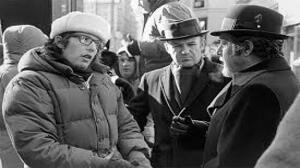William Friedkin (1971-1985)

William Friedkin’s career reflects the trajectory of a director unafraid to tackle challenging material with uncompromising intensity. Emerging as a major force in the New Hollywood era, Friedkin became known for his visceral storytelling and relentless pursuit of realism. From gritty crime dramas to supernatural horror, his work often defied convention, embracing ambiguity and moral complexity. However, Friedkin’s unyielding approach was a double-edged sword. While it earned him critical acclaim and commercial success early in this period, it also led to creative and financial risks that alienated audiences and studios. His films are bold experiments in tension and atmosphere, marked by technical innovation and a willingness to explore the darker corners of human nature.
The French Connection (1971) Friedkin’s breakout success, The French Connection, redefined the crime thriller genre with its gritty realism and raw energy. The film follows New York City detectives “Popeye” Doyle (Gene Hackman) and Buddy Russo (Roy Scheider) as they pursue an international drug smuggling ring. Based on a true story, the film captures the chaos and corruption of urban policing with unflinching authenticity. The standout sequence—a high-speed car chase through Brooklyn—remains one of the most thrilling and influential set pieces in cinema history. Friedkin’s use of handheld cameras and real locations enhances the film’s immediacy, immersing viewers in its grimy, chaotic world. Hackman’s performance as the obsessive, morally ambiguous Doyle is both magnetic and unsettling, encapsulating the film’s themes of justice and obsession. Critics and audiences alike lauded The French Connection, which won five Academy Awards, including Best Picture and Best Director, establishing Friedkin as a director who could balance commercial appeal with artistic ambition.
The Exorcist (1973) Widely regarded as one of the greatest horror films of all time, The Exorcist solidified Friedkin’s reputation as a master of tension and atmosphere. Based on William Peter Blatty’s novel, the film tells the harrowing story of a young girl possessed by a demon and the priests who attempt to save her. Friedkin approached the material with an almost documentary-like realism, using practical effects and an uncompromising shooting style to heighten the film’s terror. The performances—especially Linda Blair’s unnerving turn as Regan and Max von Sydow’s stoic Father Merrin—are hauntingly authentic. Friedkin’s meticulous attention to detail, including his use of subliminal imagery and unsettling sound design, creates a pervasive sense of dread that lingers long after the credits roll. While its graphic content sparked controversy, The Exorcist was a cultural phenomenon, becoming the highest-grossing horror film of its time and earning 10 Academy Award nominations. It remains a landmark achievement in horror cinema, showcasing Friedkin’s ability to blend visceral shocks with profound existential themes.
Sorcerer (1977) Coming off the success of The Exorcist, Friedkin set his sights on a bold reimagining of Henri-Georges Clouzot’s The Wages of Fear. Sorcerer tells the story of four desperate men tasked with transporting volatile explosives across treacherous terrain in South America. The production of Sorcerer was notoriously challenging, with Friedkin pushing cast and crew to their limits in remote jungle locations. The result is a film of staggering tension and visual grandeur, with sequences like the crossing of a rickety bridge during a torrential storm showcasing Friedkin’s mastery of suspense. Tangerine Dream’s hypnotic score adds an otherworldly quality to the film’s bleak, existential narrative. Despite its technical brilliance, Sorcerer was a box-office failure, overshadowed by the release of Star Wars. Critics and audiences were unprepared for its grim tone and lack of traditional heroism, but the film has since been re-evaluated as a masterpiece. It stands as a testament to Friedkin’s ambition and his refusal to compromise, even at the cost of commercial success.
Cruising (1980) Cruising is Friedkin’s most controversial film; a psychological thriller set in New York’s gay leather subculture. Al Pacino stars as a cop who goes undercover to investigate a series of murders, only to find his own identity and morality increasingly blurred. Friedkin’s depiction of this marginalized community sparked outrage, with activists accusing the film of perpetuating harmful stereotypes. Protests plagued its production and release, and the backlash overshadowed its artistic merits. However, viewed through a modern lens, Cruising is a fascinating exploration of repression, identity, and the intersection of sex and violence. The film’s dark, atmospheric visuals and Pacino’s understated performance contribute to its haunting, ambiguous tone. While it remains divisive, Cruising exemplifies Friedkin’s willingness to tackle difficult material and provoke uncomfortable conversations, even at the risk of alienating his audience.
To Live and Die in L.A. (1985) With To Live and Die in L.A., Friedkin returned to the crime thriller genre, crafting a stylish, nihilistic tale of corruption and obsession. William Petersen stars as a Secret Service agent bent on avenging his partner’s murder, while Willem Dafoe delivers a chilling performance as a counterfeiter whose charisma masks his ruthlessness. The film’s standout sequence—a breathtaking car chase against oncoming traffic—rivals the intensity of The French Connection’s iconic chase. Friedkin’s direction is lean and kinetic, capturing the moral decay and material excess of 1980s Los Angeles. Wang Chung’s synth-heavy score adds a layer of cold detachment, perfectly complementing the film’s themes. While not as commercially successful as his earlier works, To Live and Die in L.A. has earned a cult following for its daring storytelling and unflinching cynicism, marking a return to form for Friedkin.
Overall Appraisal From 1971 to 1985, William Friedkin established himself as one of the most fearless and uncompromising directors of his era. His films are marked by their technical innovation, narrative boldness, and unflinching exploration of humanity’s darker impulses. Whether crafting gritty crime dramas or supernatural thrillers, Friedkin brought a visceral intensity to his work that set him apart from his peers. While his refusal to compromise occasionally led to commercial misfires, it also resulted in some of the most enduring and influential films of the era. Friedkin’s ability to balance tension, realism, and thematic depth makes this period of his career a remarkable chapter in the history of American cinema.
